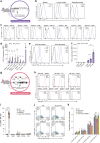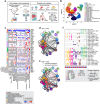Mouse fetal growth restriction through parental and fetal immune gene variation and intercellular communications cascade
- PMID: 35906236
- PMCID: PMC9338297
- DOI: 10.1038/s41467-022-32171-w
Mouse fetal growth restriction through parental and fetal immune gene variation and intercellular communications cascade
Abstract
Fetal growth restriction (FGR) affects 5-10% of pregnancies, and can have serious consequences for both mother and child. Prevention and treatment are limited because FGR pathogenesis is poorly understood. Genetic studies implicate KIR and HLA genes in FGR, however, linkage disequilibrium, genetic influence from both parents, and challenges with investigating human pregnancies make the risk alleles and their functional effects difficult to map. Here, we demonstrate that the interaction between the maternal KIR2DL1, expressed on uterine natural killer (NK) cells, and the paternally inherited HLA-C*0501, expressed on fetal trophoblast cells, leads to FGR in a humanized mouse model. We show that the KIR2DL1 and C*0501 interaction leads to pathogenic uterine arterial remodeling and modulation of uterine NK cell function. This initial effect cascades to altered transcriptional expression and intercellular communication at the maternal-fetal interface. These findings provide mechanistic insight into specific FGR risk alleles, and provide avenues of prevention and treatment.
© 2022. The Author(s).
Conflict of interest statement
A.R. is a co-founder and equity holder of Celsius Therapeutics, an equity holder in Immunitas, and was an SAB member of ThermoFisher Scientific, Syros Pharmaceuticals, Neogene Therapeutics and Asimov until July 31, 2020. From August 1, 2020, A.R. is an employee of Genentech and has equity in Roche. O.R.-R. is an employee of Genentech as of October 19, 2020 and has equity in Roche. O.A., O.R.-R. and A.R. are co-inventors on patent applications filed by the Broad Institute for inventions related to single-cell genomics, such as in PCT/US2018/060860 and US provisional application no. 62/745,259. G.M. is a director of and shareholder in Genomics plc and a partner in Peptide Groove LLP. The remaining authors declare no competing interests.
Figures







References
-
- de Onis M, Blossner M, Villar J. Levels and patterns of intrauterine growth retardation in developing countries. Eur. J. Clin. Nutr. 1998;52:S5–S15. - PubMed
-
- Romo A, Carceller R, Tobajas J. Intrauterine growth retardation (IUGR): epidemiology and etiology. Pediatr. Endocrinol. Rev. 2009;6:332–336. - PubMed
Publication types
MeSH terms
Substances
Grants and funding
- 100956/Z/13/Z/WT_/Wellcome Trust/United Kingdom
- MC_UU_12025/MRC_/Medical Research Council/United Kingdom
- MC_UU_00008/3/MRC_/Medical Research Council/United Kingdom
- RC2 DK116691/DK/NIDDK NIH HHS/United States
- 100308/Z/12/Z/WT_/Wellcome Trust/United Kingdom
- MC_UU_12010/3/MRC_/Medical Research Council/United Kingdom
- MC_UU_12009/MRC_/Medical Research Council/United Kingdom
- G0902418/MRC_/Medical Research Council/United Kingdom
- HHSN261200800001E/CA/NCI NIH HHS/United States
- HHMI/Howard Hughes Medical Institute/United States
- DH_/Department of Health/United Kingdom
LinkOut - more resources
Full Text Sources
Molecular Biology Databases
Research Materials
Miscellaneous

